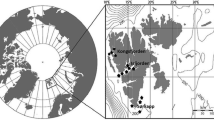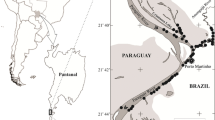Abstract
The reproductive pattern of longnose trevally (Carangoides chrysophrys) in the Arabian Sea, off the coast of Oman, is described. Samples were collected on a monthly base between April 2005 and September 2006 from two landing sites (ALlakbi and Raysuot). A single peak of the gonadosomatic index (GSI) started from September and ended in February signalling the spawning period. Values of the relative condition factor (K n ) were fairly constant throughout the year for both males and females and no significantly difference was found in the average K n values between males and females during sampling period. Male and female lengths-at 50% maturity were 46.90 and 42.08 cm, respectively and were significantly different. This study thus increases our understanding of the reproductive biology of an important commercial and artisanal fish species in one of its major distribution areas.




Similar content being viewed by others
References
Abascal FJ, Megina C, Medina A (2004) Testicular development in migrant and spawning blue fin tuna (Thunnus thynnu (L.)) from the eastern Atlantic and Mediterranean. Fish Bull 102:407–417
Al-Abdessalaam TZ (1995) Marine Species of the Sultanate of Oman. An Identification Guide, Ministry of Agriculture and Fisheries, Sultanate of Oman, Publication no. 46/95
Bagenal TB, Tesch FW (1978) Age and growth. In: Bagenal T (ed) Methods for assessment of fish production in freshwaters. Blackwell Scientific Publications, Oxford, pp 101–136
Bohlin T, Dellafors C, Faremo U (1994) Probability of first sexual maturation of male parr in wild sea-run brown trout (Salmo trutta) depends on condition factor 1 yr in advance. Can J Fish Aquat Sci 51:1920–1926
Brulé T, Renán X, Colás-Marrufo T, Hauyon Y, Tuz-Sulub AN, Déniel C (2003) Reproduction in the protogynous black grouper (Mycteroperca bonaci (Poey)) from the southern Gulf of Mexico. Fish Bull 101:463–475
Chatteriji A (1980) The relative condition factor and length-weight relationship of a freshwater carp Labes gonius (Ham.) Cyprinidae, Teleostei. J. Bombay Nat Hist Soc 77:435–443
Chu KH, Chen QC, Huang LM, Wong CK (1995) Morphometric analysis of commercially important penaeid shrimps from the Zhujiang estuary, China. Fish Res 23:83–93
Crabtree RE, Hood PB, Snodgrass D (2002) Age, growth, and reproduction of permit (Trachinotus falcatus) in Florida waters. Fish Bull 100:26–34
Devlin RH, Nagahama Y (2002) Review article: Sex determination and sex differentiation in fish: an overview of genetic, physiological, and environmental influences. Aquaculture 208:191–364
Froese R (2006) Cube law, condition factor and weight-length relationships: history, meta-analysis and recommendations. J Appl Ichthyol 22:241–253
García-Cagide A, Claro R, Koshelev BV (2001) Reproductive patterns of fishes of the Cuban shelf. In: Claro R, Lindeman KC, Parenti LR (eds) Ecology of the marine fishes of Cuba. Smithsonian Institution Press, Washington DC, pp 73–114
Gonçalves JMS, Bentes L, Lino PG, Ribeiro J, Canário AVM, Erzini K (1997) Weight-length relationships for selected fish species of the small-scale demersal fisheries of the south-west coast of Portugal. Fish Res 30:253–256
GoSO (2008) Annual Statistic Report (2007) for the Sultanate of Oman. Department of Fisheries Statistics, Directorate General of Fisheries. Research, Ministry of Fisheries Wealth, Muscat, p210
Graham RT, Castellanos DW (2005) Courtship and spawning behaviors of carangid species in Belize. Fish Bull 103:426–432
Grandcourt EM, Al Abdessalaam TZ, Francis F, Al Shamsi A (2004) Population biology and assessment of representatives of the family Carangidae Carangoides bajad and Gnathanodon speciosus (Forssk°al, 1775), in the Southern Arabian Gulf. Fish Res 69:331–341
Griffiths SP, Fry GC, van der Velde TD (2006) Population dynamics and fishery benefits of a large legal size of a pelagic sportfish, the Talang queenfish, Scomberoides commersonnianus, in northern Australia. Fish Res 82:74–86
Herrera M, Hernando JA, Fernandez-Delgado C, Bellido M (1988) Age, growth and reproduction of the barbel, Barbus sclateri (Günther, 1868), in a first-order stream in southern Spain. J Fish Biol 33:371–381
Holden MJ, Railt DFS (1974) Manual of fisheries science. Part 2. Methods of resource investigation and their application FAO Fisheries Technical Paper No. 115. Review 1. Rome, p214
Hurley MA, Matthiessen P, Pickering AD (2004) A model for environmental sex reversal in fish. J Theoretical Biol 227:159–165
Kalita B, Jayabalan N (1997) Length-weight relationship and relative condition factor of the golden scad, Caranx kalla Cuv. from Mangalore coast. Indian J Fish 44(1):87–90
King MG (1995) Fisheries biology, assessment and management. Fishing News Books, Oxford, p 341
Kondo M (1985) Oceanographic investigations of fishing grounds in the East China Sea and the Yellow Sea. I. Characteristics of the mean temperature and salinity distributions measured at 50 m and near the bottom. Bull Seikai Region Fish Res Lab 62:19–66, in Japanese with English abstract
Kritzer JP (2004) Sex-specific growth and mortality, spawning season, and female maturation of the stripey bass (Lutjanus carponotatus) on the Great Barrier Reef. Fish Bull 102:94–107
Kulbicki M, Guillemot N, Amand M (2005) A general approach to length-weight relationships for New Caledonian lagoon fishes. Cybium 29(3):235–252
Lam TJ (1983) Environmental influences on gonadal activity in fish. In: Hoar WS, Randall DJ, Donaldson EM (eds) Fish Physiology, vol 9B. Academic, New York, pp 65–116
Lebreton JD, Burnham KP, Clobert J, Anderson DR (1992) Modelling survival and testing biological hypotheses using marked animals: a unified approach with case studies. Ecol Monogr 62(1):67–118
Lieske E, Myers R (1994) Collins Pocket guide. Coral reef fishes. Indo–Pacific and Caribbean including the Red Sea. Haper Collins Publishers, p400
Lin PL, Shao KT (1999) A review of the carangid fishes (Family Carangidae) from Taiwan with descriptions of four new records. Zool Stud 38(1):33–68
Lowe-McConnell RH (1979) Ecological aspects of seasonality in fishes of tropical waters. Symp Zool Soc Lond 44:219–241
Mayrat A (1970) Allometrie et taxinomie. Rév stat appliquée 18(4):47–58
Moutopoulos DK, Stergiou KI (2002) Length–weight and length–length relationships of fish species from the Aegean Sea (Greece). J Appl Ichthyol 18:200–203
Pepin P (1995) An analysis of the length–weight relationship of larval fish: limitation of the general allometric model. Fish Bull 93:419–426
Petrakis G, Stergiou KI (1995) Weight–length relationships for 33 fish species in Greek waters. Fish Res 21:465–469
Pulliainen E, Korhonen K (1990) Seasonal changes in condition indices in adult mature and non-maturing burbot, Lota lota (L.), in the north–eastern Bothnian Bay, northern Finland. J Fish Biol 36:251–259
Rayner NA, Parker DE, Horton EB, Folland CK, Alexander LV, Rowell DP, Kent EC, Kaplan A (2006) Global analyses of sea surface temperature, sea ice, and night marine air temperature since the late nineteenth century. J Geophys Res 108:4407
Sadovy Y (1996) Reproduction of reef fishery species. In: Polunin NVC, Roberts CM (eds) Reef fisheries. Chapman and Hall, London, pp 15–59
Safran P (1992) Theoretical analysis of the weight–length relationships in the juveniles. Mar Biol 112:545–551
Smith-Vaniz WF (1984) Carangidae. In: Fischer W, Bianchi G (eds) FAO Species Identification Sheets for Fishery Purposes. Western Indian Ocean Fishing Area 51 Vol. 1. FAO, Rome
Stengel H, Al Harthy A (2004) The Traditional Fishery of the Sultanate of Oman (Fishing Gears and Methods). Ministry of Agriculture and Fisheries, Directorate General of Fisheries Resources. Muscat, Sultanate of Oman, p147
Tokimura M (1992) Distribution of primary bottom-fishes in the East China Sea and Yellow Seas during the winter season of 1991. Seikai Block Sokouo Chosa Kenkyu Kai Ho 3:15–39 (in Japanese)
Tveiten H, Mayer I, Johnsen HK, Jobling M (1998) Sex steroids, growth and condition of Arctic charr broodstock during an annual cycle. J Fish Biol 53:714–727
West G (1990) Methods of assessing ovarian development in fishes: a review. Aust J Mar Freshwater Res 41:199–222
Wu CC, Su WC, Kawasaki K (2001) Reproductive biology of the dolphin fish Coryphaena hippurus on the east coast of Taiwan. Fish Sci 67:784–793
Zar JH (1984) Biostatistical analysis. Prentice-Hall Inc, Englewood Cliffs, p 718
Acknowledgements
The authors would like to acknowledge the assistance from the staff of the Ministry of Fisheries Wealth in collecting the samples and data management. We thank Yong Chen (University of Maine), Ewen Mclean (University of Trinidad and Tobago) and two anonymous referees for their helpful comments on an earlier draft of this manuscript. This project was financially supported by the Agriculture and Fisheries Research Fund of the Sultanate of Oman.
Author information
Authors and Affiliations
Corresponding author
Rights and permissions
About this article
Cite this article
Al-Rasady, I., Govender, A. & Al-Jufaili, S.M. Reproductive biology of longnose trevally (Carangoides chrysophrys) in the Arabian Sea, Oman. Environ Biol Fish 93, 177–184 (2012). https://doi.org/10.1007/s10641-011-9903-2
Received:
Accepted:
Published:
Issue Date:
DOI: https://doi.org/10.1007/s10641-011-9903-2




